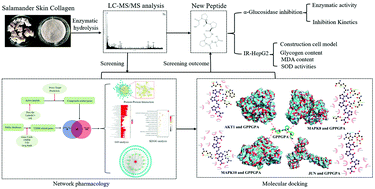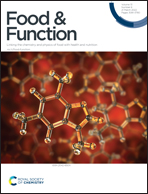Screening and identification of a novel antidiabetic peptide from collagen hydrolysates of Chinese giant salamander skin: network pharmacology, inhibition kinetics and protection of IR-HepG2 cells†
Abstract
In this study, a novel peptide GPPGPA was screened from the collagen hydrolysates of Chinese giant salamander (Andrias davidianus) skin, and its anti-diabetes mechanism was predicted by network pharmacology, and an inhibitory effect on α-glycosidase and protective effect on IR (insulin resistance) and oxidative stress of IR-HepG2 cells were detected. Through network pharmacology screening, GPPGPA was found to have good drug-like properties, and 103 targets of GPPGPA overlap with T2DM targets. These targets were mainly enriched in the PI3K-Akt signaling pathway associated with T2DM, the AGE-RAGE signaling pathway in diabetic complications, the TNF signaling pathway, insulin resistance and so on. The core targets were identified as AKT1, MAPK8, MAPK10 and JUN by constructing a “peptide-target-pathway” network. The molecular docking results showed that GPPGPA was well bound to the core targets. These results suggested that GPPGPA had the potential to reduce T2DM. Further in vitro experiments showed that GPPGPA as a competitive inhibitor could effectively inhibit the activity of α-glucosidase. The results of the IR-HepG2 cell model experiments showed that GPPGPA was not toxic to HepG2 cells, and could reduce IR of HepG2 cells induced by high-glucose and high-insulin, improve glucose consumption, increase the activity of superoxide dismutase (SOD), and reduce the content of malondialdehyde (MDA). The above results suggested that GPPGPA could improve T2DM by reducing insulin resistance through a multi-target and multi-pathway mechanism. GPPGPA could be developed and utilized as a novel hyperglycemic inhibitor in functional food.

- This article is part of the themed collection: Food & Function HOT Articles 2022


 Please wait while we load your content...
Please wait while we load your content...